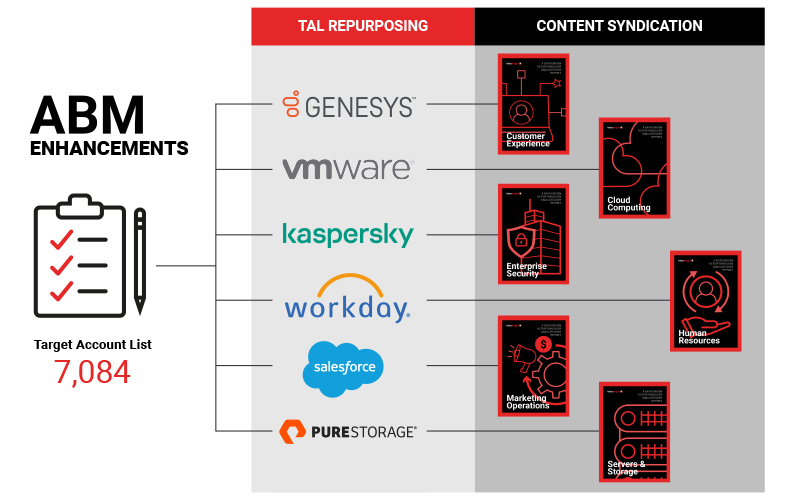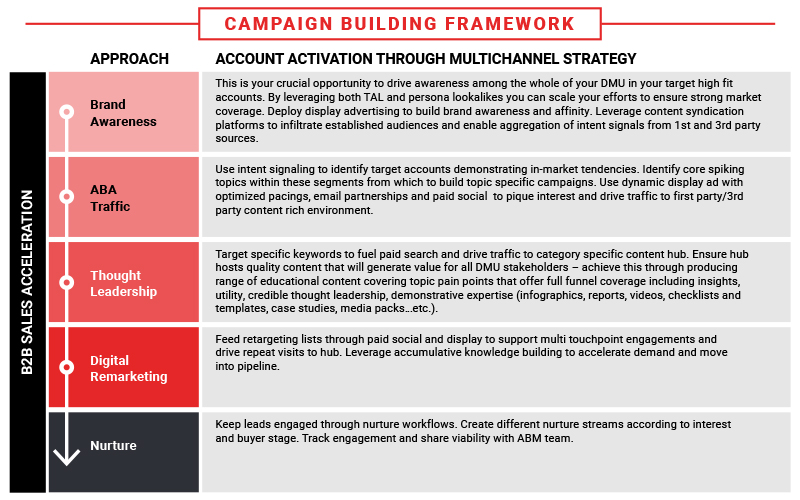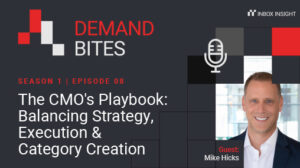Make your revenue goals a reality with these Account-Based Marketing (ABM) strategic plays – here’s 5 approaches that can be used to create an overarching ABM campaign that delivers engaged leads from the accounts on your hit list.
What’s more, they don’t rely on heavy tech investment and can be easily scaled – making them perfect for businesses of all sizes and ABM capabilities.
So if you’re looking to role out a new GTM strategy but want to pilot it first, just starting out on your ABM journey or are looking to supplement your existing ABM strategy with high quality leads – these plays are for you.
Reading time: 5 minutes
Follow these Account-Based Marketing strategies to drive revenue potential and increase pipeline profitability…
ABM play #1: Always-on brand awareness

Crucial to driving awareness and interest among all decision-making unit (DMU) members is to maintain always-on brand awareness. Top of the marketing funnel, awareness is a key factor when it comes to educating B2B buyers at the initial stage of the buyer journey – which is why it’s so important to ensure a set of top funnel messaging is always on.
The C-suite are unlikely to be captured as leads but you can reach them via Account-Based Advertising (ABA) channels instead – for instance through Programmatic Display, Paid Social (e.g. LinkedIn / Facebook ads) and Email Marketing and once they have engaged you can then re-target them.
Always-on brand awareness is a necessity when it comes to the buying process as it keeps driving relevant, informative messaging to the buying committee in a subtle yet meaningful way. This tactic goes a long way in keeping your brand front of mind, allowing brand champions to be built within accounts as well as influencers who begin to truly recognize the benefits your solution could provide them.
It is also an essential component of Programmatic (one-to-many) ABM, which enables B2B marketers to relay personalized content to a specific segment of their target audience with considerable commonalities. This means you can target all of your Target Account Lists (TALs) to build awareness and market presence.
Another crucial Account-Based Marketing tactic here is content syndication. Owned content is republished onto other sites, enhancing the reach of your content marketing efforts within your target market while allowing new audiences to be reached. This drives greater traffic to your website and can be a highly effective content marketing strategy. You can make this channel super effective by:
- Breaking down TALs into category clusters
- Creating relevant content around those categories
- Delivering content syndication to clusters via third party partners that have audiences matching your Ideal Customer Profile (ICP), and with an active interest in category areas. This allows the effective delivery of personalization at scale.

ABM play #2: Demand acceleration through ABA

Accelerating demand is the pivotal goal here, through intercepting accounts already displaying high buyer intent via targeted dynamic display ads, paid social and email partnerships.
Account-based advertising channels can be used to drive your target companies to highly relevant, content rich environments where superior value exchanges can occur. This allows for an abundance of varied content and formats to be readily available, satisfying each stage of the buying journey with the right content at the right time in one easy-to-access place. As a result, you’re able to resonate with your in-market buyers’ pain points and be ready to intercept with your solutions.
Key to getting this right is to ensure your ad messaging is super focused around these pain points and around your intent topic to attract, engage and drive action.
ABM play #3: Thought leadership

ABM play #2 is most effective if you create a content rich environment underpinned by a solid thought leadership strategy. Expert, trustworthy content places your brand highly in the eyes of B2B marketers looking to instill their trust in a solution provider. By fulfilling their information needs you are providing superior value exchanges. You will become the go-to for reliable, up-to-date, relevant content that aids decision making within the buying committee.
Establishing a reputation as an industry expert demonstrates your ability to host a variety of different content and formats that engage your DMU community. It requires a high density of quality, educational content based around a central theme, in a range of formats pitched to different buyer stages and DMU members. This facilitates multi touchpoint engagement thanks to the variety of content types across various marketing channels to potential customers showing a high propensity to purchase.
The value of content hubs to demonstrate expertise
What’s more, having a whole library of valuable content at your fingertips makes the perfect ingredient for a content hub. Curating a collection of your content specific to a topic allows B2B marketers to thoroughly explore a theme with the reassurance that the content holds authority, reliability and validity. Content hubs offer full funnel coverage and demonstrate profound expertise through showcasing a range of research reports, infographics, videos and webinars, utility guides and templates, case studies, media packs and so on, all in one place.
You should target specific keywords to fuel paid search and drive traffic to your category specific content hub as this is where you want to direct your in-market buyers. It’s wise to utilize tracking to monitor engagement on both account and individual levels, which can be used for remarketing activities (see ABM play #4) and driving audience intelligence into your Account-Based Marketing strategy. Paid search can also help draw in conversions from users searching for theme terms so should be leveraged and closely monitored.
Making as much of your content gate-free as possible in order to optimize for conversions is a valuable thought leadership tactic. Carefully consider which are your primary conversion points and how you are going to optimize them – though be sure not to give away too much of your most valuable insights in ungated content as this isn’t the aim, you simply want to build interest, demonstrate expertise, and entice readers to download the overarching gated asset relating to the topic they’ve shown interest in.
ABM play #4: Digital remarketing

Digital remarketing is a powerful play for harvesting interest and transforming interest into action – conversions. B2B marketers serve ads to visitors of their website or a specific webpage who have taken no specific action as a result of their visit. In order to get your sales pipeline velocity pumping, remarketing can be used to engage previous site visitors who have shown a clear interest in your product or service offering.
They may not have converted for a variety of reasons – they might simply be in the initial research stage of their buying cycle for instance, but what differentiates them and makes them worth pursuing is their early-stage buyer intent.
Sequential messaging is a highly advantageous tactic to use here. This marketing approach involves serving a series of related, relevant and educational marketing messages or ads to a targeted audience over a given time. This makes for engaging, consistent customer experiences through delivering a range of messages that build on one another – allowing a story to effectively be told, guiding potential B2B customers through the buying process.
By using a series of messages that are linked together, marketers can create more personalized campaigns, helping to build trust, further demonstrate thought leadership and establish a strong relationship.
You should feed your retargeting lists through paid social and display to drive repeat hub visits and support multi touchpoint engagements. This will encourage accumulative knowledge building, aiding pipeline acceleration and driving demand.
ABM play #5: Nurture

Keeping your prospects and customer base engaged by subtly nudging them through the buying process makes nurture a vital component for any marketing team. This can be achieved via a series of nurture emails for instance, delivering relevant content relating to the theme that interest has been shown towards. Drip feeding information and insights in this way not only further demonstrates thought leadership, it also ensures your business remains front of mind.
Nurture activities can be tracked for engagement, which can be shared with your ABM team to give them visibility over key accounts engaging and with what content, to depict what stage of the customer journey they are at. Your nurture sequence aims to walk them through this journey, delivering infographics, videos and so on at the most relevant times along it to build knowledge over time.
This also makes way for your sales team to engage with leads at key touchpoints once they’ve identified where’s best to intercept – requiring strong marketing and sales alignment throughout.
Campaign building framework to drive B2B sales acceleration

What distinguishes this framework from traditional demand generation is:
-
- Target Account Lists (TALs)
- Different ways of using your TALs – i.e. brand awareness, using ALL of your tiers despite whether they are in-market or not.
5 ABM plays away from your sales pipeline pumping…
Adopt these 5 approaches within your marketing activities to create an overarching ABM campaign that delivers high quality, engaged leads from your list of target accounts. Wherever you are in your ABM journey, there’s no need to rely heavily on tech investments – simply follow these plays and an increase in pipeline will follow.






